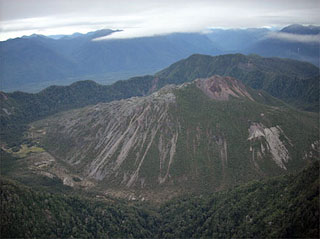Report on Chaiten (Chile) — 13 May-19 May 2015
Smithsonian Institution / US Geological Survey
Weekly Volcanic Activity Report, 13 May-19 May 2015
Managing Editor: Sally Sennert.
Please cite this report as:
Global Volcanism Program, 2015. Report on Chaiten (Chile) (Sennert, S, ed.). Weekly Volcanic Activity Report, 13 May-19 May 2015. Smithsonian Institution and US Geological Survey.
Chaiten
Chile
42.8349°S, 72.6514°W; summit elev. 1122 m
All times are local (unless otherwise noted)
On 17 May, OVDAS-SERNAGEOMIN reported that seven hybrid earthquakes were detected beneath Chaitén at a depth of 1 km; the highest local magnitude recorded was 3.6. A second report on 19 May noted that seismicity had slightly increased during the previous few months, characterized by an increase in magnitude and occurrence of long-period events, volcano-tectonic events, and hybrid events. Thermal anomalies from the lava dome complex had also been detected although the report did not state when. The Alert Level was raised to Yellow, on a three-color scale.
Geological Summary. Chaitén is a small caldera (~3 km in diameter) located 10 km NE of the town of Chaitén on the Gulf of Corcovado. Multiple explosive eruptions throughout the Holocene have been identified. A rhyolitic obsidian lava dome occupies much of the caldera floor. Obsidian cobbles from this dome found in the Blanco River are the source of artifacts from archaeological sites along the Pacific coast as far as 400 km from the volcano to the N and S. The caldera is breached on the SW side by a river that drains to the bay of Chaitén. The first recorded eruption, beginning in 2008, produced major rhyolitic explosive activity and building a new dome and tephra cone on the older rhyolite dome.
Source: Servicio Nacional de Geología y Minería (SERNAGEOMIN)

